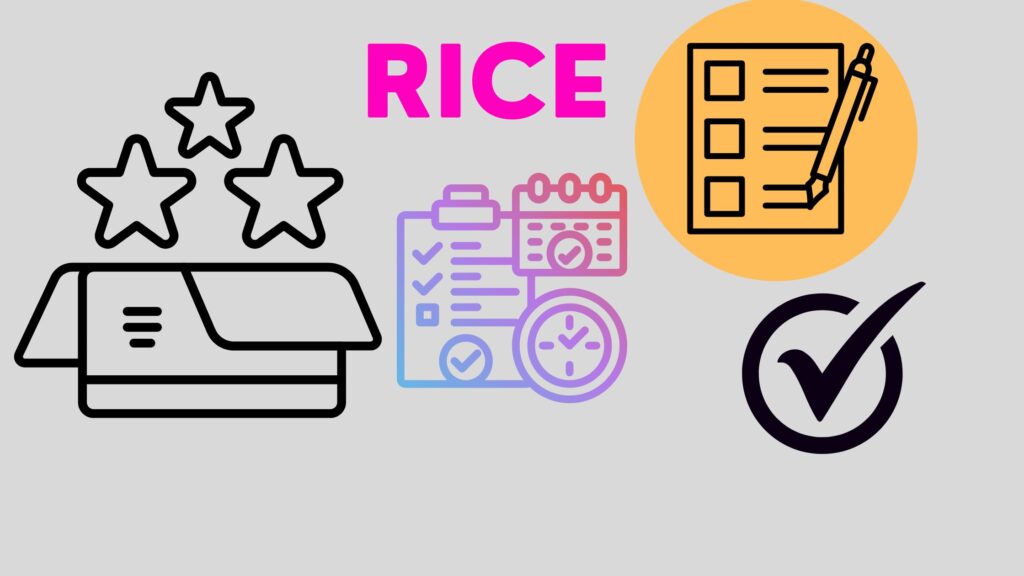In this article, I will explain about the RICE framework for prioritization. This is used by Product Managers to evaluate and prioritize the product ideas/new features etc.
RICE stands for:
R – Reach
I – Impact
C – Confidence
E – Effort
RICE is the framework. Used by Product Managers.For prioritization.Intercom is the pioneer of the RICE framework.
Is it required? Why to use framework for prioritization?
Because prioritization is difficult.
Why is Prioritization difficult ?
Prioritization is challenging. Depends on the mindset of Product managers. And also engineering teams.
Here are some reasons.
- We always tend to work on our favorite product ideas first
- We feel excited to work on news ideas first.
- Teams tend to focus on innovative ideas, rather than focusing on goals set by organization or teams
- Loss of interest in long time ongoing development
- Sometimes, we feel are tasks/features are of priority
Why Framework is Needed For Prioritization ?
Prioritization is important. Teams need to work towards achieving goals and company vision.
Quantitative and qualitative analysis is required for prioritizing product ideas.
The process of prioritization should be data driven.
Therefore a structured approach or a framework is a must for prioritization..
What is RICE Framework?

RICE is the framework. Used by Product Managers.For prioritization.
RICE is the scoring model.
Intercom are the pioneers of the RICE framework.
RICE stands for:
R – Reach
I – Impact
C – Confidence in Reach and Impact
E – Effort required to deliver
By evaluating Reach, Impact of ideas, Confidence in Reach & Impact and Effort required to deliver the product/feature/enhancement , a score is arrived at.
How is the RICE score calculated :
RICE Score= (Reach X Impact X Confidence) / Effort
This is called the RICE score.
This RICE score is a valuable input for Product Managers to prioritize the product ideas.
Let us understand RICE in detail:
Reach:
Reach is the first factor considered for prioritization.
This is the estimate of how many users will use this new product or feature within a timeframe.
We have to define clearly what ‘reach’ means and what is the time required to measure it.
That is people or events per time period.
There is no fixed rule here.
Time period can be in weeks, months or quarters.
It can be subscribers per quarter or transactions per month
Example:
- If feature 1 is implemented,1000 new customers will subscribe in a quarter. So, the ‘reach’ score is 1000 here.
- If feature 3 is implemented,600 new customers will subscribe in a quarter. So, the ‘reach’ score is 600 here
Impact:
Impact can be quantitative and qualitative.
Quantitative can be how many conversions will result after customers use them.
Customer delight is the qualitative impact.
This is the estimated score.
According to Intercom, here is the Impact scoring system.
| Minimal Impact | 0.25 |
| Low Impact | 0.5 |
| Medium Impact | 1 |
| High Impact | 2 |
| Massive Impact | 3 |
Examples:
- Marginally Increased conversion rate for feature 1: Impact = 2
- Increased conversion rate for feature 2 :Impact = 3
Confidence:
This factor is the level of confidence a Product Manager has on the estimates for Reach & Impact.
This helps in ruling out highly enthusiastic bad ideas.
Confidence is represented in terms of percentage.
This is used to adjust the data backed estimates on Reach and intuition of impact.
According to Intercom, here is the Confidence scoring system.
| Low confidence | 50% |
| Medium confidence | 80% |
| High confidence | 100% |
Examples:
- Confidence is 80% when new feature 1 is launched
- Confidence is 100% when new feature 2 is launched
Any product idea which has less than 50% confidence is a good candidate to drop off. Or it can be of low priority.
Effort:
Effort is the estimate of resources required to deliver the product.
While other 3 factors- Reach,Impact & Confidence represent the benefits of the product, Effort represents the cost of delivering the product.
Effort is scored in terms of time required to develop and deliver.
This includes the effort from all teams-Product Design, Engineering teams.
Typically, it is in man-months.
Examples:
- Estimated effort for delivering feature 1 is 3 months
- Estimated effort for delivering feature 2 is 5 months
Example for RICE Score Calculation:
| Features | Reach score | Impact score | Confidence Score | Effort | RICE Score= (R * I * C)/E |
| Feature 1 | 1000 | 2 | 0.8 | 3 | 533.33 |
| Feature 2 | 600 | 3 | 1 | 5 | 360 |
Therefore in comparison, Feature 1 has a higher RICE score.
This can be prioritized for delivery.
Note: RICE framework is the input for deciding the prioritization. Other factors like dependency are to be considered while prioritizing the ideas for development.
Conclusion
RICE is the simple framework for prioritizing product ideas. It uses both the data and Product Manager’s intuition.
RICE score is the input for Product Manager to prioritizing the ideas for delivery



